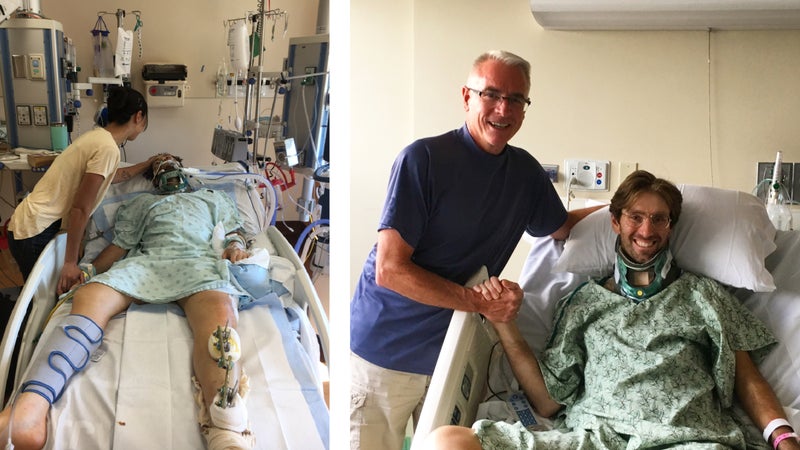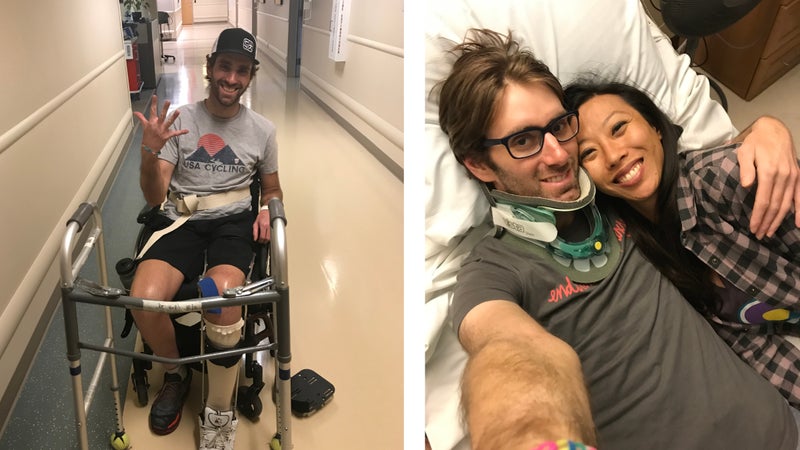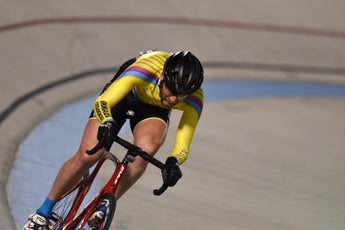To the Driver Who Hit Me and Ran
I was biking home when you barreled into me with your car and left me to die
New perk: Easily find new routes and hidden gems, upcoming running events, and more near you. Your weekly Local Running Newsletter has everything you need to lace up! .
Here’s what you did when you hit me with your van. And, yes, I understand that it almost certainly wasn’t you who hit me, but since what happened to me was caused by an unidentified assailant who was likely driving while either distracted, drunk, high, using a phone, speeding, or just angry that there was a cyclist on the road, and as you have probably driven in one or more of those states, this is about you and what you did to me—and��what you could do to another cyclist.
You plowed into me from behind when I was riding on a nearly empty road. Your speed was so fast relative to mine that I was guaranteed severe injury, despite my safety tokens: a helmet, a blinky light, and a defensive posture��on the right edge of the wide shoulder. Your van hit me with such violence that pieces of your vehicle and mine scattered along the grassy embankment. The impact flung my body through the air, and I landed at the bottom of a roadside ditch.��
This Is Every Cyclist Who Was Killed by a Driver in 2020
It hasn’t been this dangerous to ride a bicycle on American roads in three decades.The blunt impact sent force vectors through my body, snapping my right collarbone and exploding my left shoulder. It broke every single one of my ribs. And my sternum. It collapsed both of my lungs. You shattered my left ankle, broke my tibia and fibula, and snapped my femur. You crushed my pelvis and caused internal bleeding so severe that my blood pressure didn’t stabilize for days, even after emergency surgery and pint after pint of transfused blood. You fractured vertebrae in my neck and back and damaged my spinal cord, paralyzing my left leg and compromising my bladder and bowel function.
That would have been enough,��lifetimes’ worth of trauma to pass to an unsuspecting 34-year-old man heading home to spend the evening with his fiancée after an afternoon of training for the season’s last big bike race.
But you’re a special kind of cruel, so you drove away.
You left me to die.
And I would have died if Tim Gillach, a cyclist and insurance salesman��from Colorado’s Front Range,��hadn’t caught a fleeting glimpse of my face as he drove past. Although he wasn’t certain he’d seen a person, he turned his car around to look again. He spotted the red bike you destroyed. He saw a helmet. He pulled over.
He found me lying in the grass, without any visible wounds or bleeding��but in obvious distress. “I saw a man struggling for every single breath,” he told me later, describing my left leg as “pointing every which way.” He��tried to reassure me as we waited for the ambulance.
“Don’t worry,” he told me,��recalling his own brutal experience.��Just a few months prior, a distracted driver had hit Gillach��with her car while he��was riding his bike near his home in Arvada, Colorado. The crash broke his pelvis. “They put my 58-year-old body back together, and they will put your body back together,” he said to me. “Just keep breathing.”

The first person charged with putting me back together was Dr. Laughlin McCollester, attending emergency physician at the Boulder Community Health emergency department. “You were clinging to life,” he told me recently. “You would not have made it another half-hour without a blood transfusion and other interventions.” When he first got the call that I was about to arrive in his emergency department��and heard about how I’d been hit, he knew he’d be looking at a severely injured patient. “We had to prioritize the life-threatening issues, what would kill you first,” he said. “If we lost your airway, if we didn’t get those chest tubes in fast, that kind of stuff. You were so weak and so depleted, you required maximum aggressive care.”
McCollester points��to the laws of physics as the main explanation for the severe level of injuries sustained in a bike-versus-car crash. “It comes down to kinetic energy, the energy inherent in a mass that’s moving,” he says. “If you have a van that’s traveling at a high rate of speed,��that is an incredible amount of kinetic energy.” When a human body absorbs that amount of kinetic energy, force vectors travel through bone and tissue, causing all manner of blunt-force injuries as they go.��
My only memory of the flight to Denver Health is the sound of thumping helicopter rotors, which came to me in drug-induced fever dreams that blended elements of reality with nightmarish inventions of my mind and always ended with me stuck on my back, unable to move.
In the emergency room, McCollester immediately cut into both sides of my rib cage to relieve pressure, helping my lungs reinflate. He and his colleagues��inserted two tubes to drain blood that had been collecting in my chest. I couldn’t breathe on my own, so they sedated me and then intubated me, forcing��a tube down my throat and into my lungs, before completing extensive scans of my whole body.
Their full-body images revealed catastrophic damage: so many broken bones that they decided to fly me to a bigger facility. “You needed five to seven surgeons working on you at once,” he told me, adding that I was one of the three worst blunt-force trauma patients he’d treated in his nearly 20-year career. With all of my emergency care focused on stabilizing my breathing and controlling the bleeding, it wasn’t until later that��doctors realized my spinal cord had been damaged as well.
My only memory of the flight to Denver Health is the sound of thumping helicopter rotors, which came to me in drug-induced fever dreams over the following weeks and blended elements of reality with nightmarish inventions of my mind. They always ended with me stuck on my back, unable to move. My loved ones took comfort in knowing I wouldn’t remember the horrors of the ICU:��The breathing tube that stayed in my throat for nine days and would give me coughing fits that felt like I was choking and gasping for air. The restraints that kept me in a fixed position in my bed hour after hour. The ten surgeries I endured over 17 days to fix my shoulder, pelvis (a common injury in bike-versus-car crashes, McCollester notes), femur, tibia, ankle, and spinal column. Being deprived of any nutrition—not even from a feeding tube—for six days. When I was weaned off sedation and came to eight days later, I remember endless thirst.��I wanted a drink of water��but wasn’t allowed any for several more days until speech pathologists helped me relearn to swallow. It was almost two weeks before I began to claw myself away from the drugs’ effects and understand the reality of what had happened to me.
Even then��the near constant anesthesia and pain meds made me crazy. On a few occasions, I attempted to pull out the many tubes going into my body. Once, when I’d been granted a respite��from my cloth wrist restraints, I successfully pulled a feeding tube from my nose and remember the satisfying feeling of it coming free—and the blinding pain of it being forced back in. An ICU nurse who helped take care of me said recently that my erratic behavior is common for patients on strong painkillers��and sedatives. What seemed normal to the medical staff was deeply unsettling to my family, who had never seen me come so unhinged.
Would my leg still be paralyzed if the doctors had been able to perform that surgery sooner? I wouldn’t have to wonder��if you hadn’t driven into me.
My hallucinations were even more unnerving. In one memorable incident, I told my family that the nurses were beating me up. Gloria and Eric, my fiancée and brother, insisted they weren’t, and it took months for me to realize that, in the early days after the crash, my body was so broken that any attempt to touch me or move me resulted in anvil-dropped-on-the-foot levels of discomfort. On a pain scale of one to ten, my existence was a constant 15; it’s no wonder I thought the nurses were secretly torturing me.��
But it’s the work that was needed to repair my back that now haunts me. I remember when I first realized that the warm, stubbly mass in the bed with me was my leg. Gloria told me recently that when she, my dad, and my brother initially explained my spinal-cord injury to me, I told them that I already had a sense that something of the sort was wrong; that��mass attached to my left��hip didn’t move when I told it to.��
The violent impact with your vehicle did so much damage to my spine that it required two separate operations—one from the back to fuse it��and another from the front to remove fragments of bone and to insert metal cages. Between the two procedures, I got an infection. The resulting illness, though not unusual for a very sick person in a hospital, delayed the final operation by five days. Would my leg still be paralyzed if the doctors had been able to perform that surgery sooner? I wouldn’t have to wonder��if you hadn’t driven into me.
After nearly a month at Denver Health, I was transferred to a long-term-care hospital to rest and heal ahead of rehab.��
The first time I stood, it was thanks to an occupational therapist, a person half my size, who pulled me to my feet. It was the hardest thing I’ve ever done. Standing. I have more than three decades of experience being upright but only managed a few seconds before collapsing back into bed.��
I was eventually transferred to Craig Hospital, a facility just outside Denver that specializes in rehabilitating spinal-cord and traumatic brain injuries, both common among cyclists who are��hit by cars. The therapists there taught me to walk using forearm crutches and a brace that extends��from my foot to my upper thigh. It locks my knee, essentially giving me a peg leg. The nurses and doctors helped me figure out the right cocktail of laxatives to get my bowels—neurologically stunned from the trauma—moving regularly but not urgently. I learned how to insert a catheter into my penis since my bladder was (and remains) stubbornly napping, and when I could shakily ambulate on my crutches and brace, albeit not yet fast enough to safely cross a street, they sent me home.

Now, more than nine months since the crash, I still wake up in pain every day. The way I walk, stiff legged and with a severe jolt, causes imbalance and a tightness that pulls on muscles, ligaments, bones, and joints throughout my lower back, abdomen, and hips. It all hurts like crazy. Sometimes I’m super stiff. Other times my tailbone burns for no apparent reason��or my hip aches from the overly tight muscles pulling bones violently together. I’m barely able to reach my left arm above my head. And there’s nerve pain that constantly sparkles, radiates, pulses, and tingles up and down my paralyzed left leg. It’s worse in the cold.��
Four manual-therapy and bodywork appointments (now only two, due to COVID-19) each week help to ameliorate the aching, stabbing, and burning, but they’ve never come close to making it go away. I rarely take pain meds, but early on, when the pain was worse, I was told over the phone that one of my doctors didn’t want to refill a prescription for Tramadol. Since the doctor wouldn’t medicate me, I politely asked her assistant if she would like to take some of the pain on herself. I clicked off my phone and realized that this is exactly how a person could get addicted to opioids and turn to illicit sources, just to not hurt.��
In physical therapy, I’ve been relearning to walk. First, therapists helped me master my brace. Then they heaped on exercises to help strengthen my leg and correct imbalances. Now��I’m spending more and more time with my brace’s knee joint unlocked, gingerly stepping across my living room, catching myself on my crutches when my fledgling quad strength inevitably fails. I practiced minute movements in a waist-deep pool for six months, and I walk on a treadmill designed to reduce gravity, environments where I can confidently take steps without my crutches. I’ve taken to calling the world outside the pool��“the heavy place,” a world where I have to roll myself around in a wheelchair any time I’m not strapped into the thigh-high brace.
And despite all that, I’m lucky: my injury is low in my spine, partially hindering my left leg��but leaving me with normal function in my right leg, my arms, and my most important organs. From my time at Craig Hospital, I know a lot of other spinal-cord patients who are much more impaired.��
There are also injuries that cause a different kind of pain. I recently asked Emily Markley, a psychologist who treated me at Craig, how getting hit by your car might affect a person. She ran through some common symptoms of post-traumatic stress disorder: hypervigilance, recurring memories of an incident, and avoidance, as well as other typical effects like survivor’s��guilt��and substance abuse. Just when I started to pat myself on the back, checking off all the symptoms I’d steered clear of, she started talking about difficulty finding joy.
I love riding my bike. Or, I loved it. I can’t keep the tense straight anymore. It’s been so long since I’ve pedaled outside that, despite the classic adage, I’m worried I won’t remember how. I spend hours thinking about how I’ll manage to get my near useless left leg onto a pedal—and then safely back on the ground. When you hit me with your van, I was on my way home from training at the Boulder Valley Velodrome. I was halfway through an exciting season of racing my track bike all over the country. I was riding well and spending time with friends.
Now my racing career is over. Worse than that, my life—a life that was centered around cycling and being outside—is permanently altered. I began racing bikes in high school. Before this crash, I rode my bike six or seven days a week. Without bikes to connect me to friends, and without the ability to do much outdoors at all, I often feel isolated, lonely.��
One source of comfort has been sharing my story. My friends say my fight to regain strength is inspiring, and they thank me for my openness. And while I’m glad to offer strength to anyone who may be facing a challenge, that’s not why I’m sharing this story. My goal is to make you a safer driver.��
I’ve taken to calling the world outside the pool��“the heavy place,” a world where I have to roll myself around in a wheelchair any time I’m not strapped into the thigh-high brace.
I know it’s highly unlikely that you hit me with your car, but I also know that it’s likely you exhibit dangerous behaviors when driving—every driver does from time to time. So I’m sharing my story to show you what you could do to your friend, coworker, neighbor, or just some person who doesn’t deserve to become paralyzed as a result of your carelessness. I’m sharing my story so that every time you drive over the speed limit, glance down from the road to see a notification on your phone, don’t quite make it through the intersection before yellow turns to red, or get behind the wheel after a boozy dinner, you will think of me living with chronic pain and struggling on my crutches, and maybe you’ll slow down a little��and refocus on the road.
I used to be whole and able-bodied, same as you. When you get behind the wheel, you have incredible power to rob someone of their body. I’m sharing my story to remind you of your responsibility to drive safely, lest you end up maiming someone like me and living with the guilt of causing their lifelong disability or death.




